
Selaginella is the sole genus in the family Selaginellaceae, the spikemosses or lesser clubmosses, a kind of vascular plant.
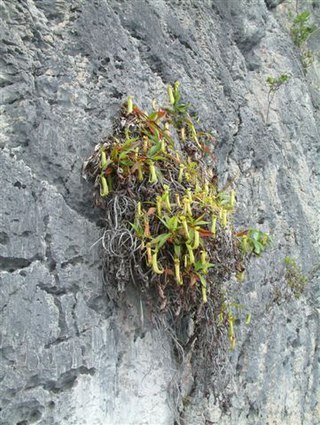
Lithophytes are plants that grow in or on rocks. They can be classified as either epilithic or endolithic; epilithic lithophytes grow on the surfaces of rocks, while endolithic lithophytes grow in the crevices of rocks. Lithophytes can also be classified as being either obligate or facultative. Obligate lithophytes grow solely on rocks, while facultative lithophytes will grow partially on a rock and on another substrate simultaneously.

Brachychiton rupestris, commonly known as the narrow-leaved bottle tree or Queensland bottle tree, is a tree in the family Malvaceae native to Queensland, Australia. Described by Sir Thomas Mitchell and John Lindley in 1848, it gained its name from its bulbous trunk, which can be up to 3.5 metres (11 ft) diameter at breast height (DBH). Reaching 10–25 metres (33–82 ft) high, the Queensland bottle tree is deciduous, losing its leaves between September and December. The leaves are simple or divided, with one or more narrow leaf blades up to 11 centimetres (4 in) long and 2 centimetres (0.8 in) wide. Cream-coloured flowers appear from September to November, and are followed by woody boat-shaped follicles that ripen from November to May. No subspecies are recognised.
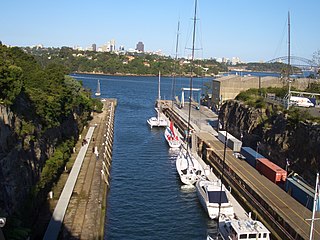
Woolwich Dock is a former dry dock and shipyard in Woolwich, Sydney, New South Wales, Australia. The site was purchased by Morts Dock and Engineering Company in 1898. When it was officially opened on 4 December 1901 it was the biggest dry dock in Australia, at 188 metres (617 ft) long and 27 metres (89 ft) wide.

Aspidotis densa is a species of fern in the Cheilanthoid subfamily, known by the common name Indian's dream or Serpentine fern or dense lace fern. It is native to the west coast of North America from British Columbia to California and east to the Rocky Mountains in Idaho, Montana, and Wyoming; there is a disjunct population on serpentine soils in Quebec.
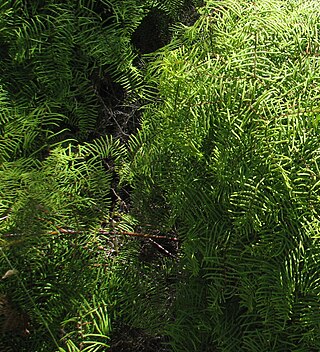
Gleichenia is a genus of ferns. Its closest relative is the genus Stromatopteris, restricted to New Caledonia.
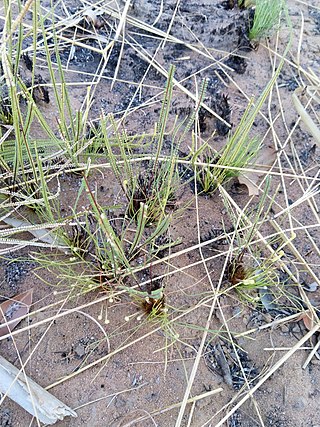
Pteris platyzomopsis, synonym Platyzoma microphyllum, is a fern in the family Pteridaceae. When placed in the genus Platyzoma, it was the only species; the genus was sometimes placed in its own family, Platyzomaceae. The species is native to northern Australia, occurring in the Kimberley region of Western Australia, in the Northern Territory and Queensland, and in northern New South Wales, where it is considered endangered. Vernacular names include braid fern.

Pyrrosia rupestris known as the rock felt fern is a common fern of eastern Australia. Occurring as an epiphyte or lithophyte in areas of part shade and high moisture. Usually found in rainforest or moist eucalyptus forest. Often seen on rainforest trees, quite high above the ground. However, it grows as far west at the more arid Warrumbungle National Park. In drought it shrinks and becomes desiccated. With rain or mist the fern recovers well.

Empodisma minus, commonly known as (lesser) wire rush or spreading rope-rush, is a perennial evergreen belonging to the southern-hemisphere family of monocotyledons called the Restionaceae. The Latin name Empodisma minus translates to “tangle-foot” “small”. E. minus is found from Queensland to South Australia, Tasmania and throughout New Zealand south of 38 ° latitude, or the central north island. Its current conservation status is “Least concerned”. In 2012 the new species Empodisma robustum was described in New Zealand, with what was previously described as E. minus from the lowland raised bogs of Waikato and Northland now being re-classified as E. robustum. E. minus remains an important peatformer in the south of New Zealand and in high altitude peatlands.

Gleichenia dicarpa, commonly known as pouched coral fern or tangle fern, is a small fern of the family Gleicheniaceae found in eastern Australia, New Caledonia and New Zealand. It forms tangled thickets in wet places such as swamps and riverbanks.

Gleichenia microphylla is a small fern growing in Australia and New Zealand.

Fieldia australis, usually referred to as fieldia, is a small climbing plant or epiphyte found in eastern Australian rainforests. Commonly seen in the cooler rainforests at higher altitudes. It also grows in the warmer rainforests with a high humidity. The plant uses adventitious roots to grip hold of tree trunks, mossy rocks or tree ferns.
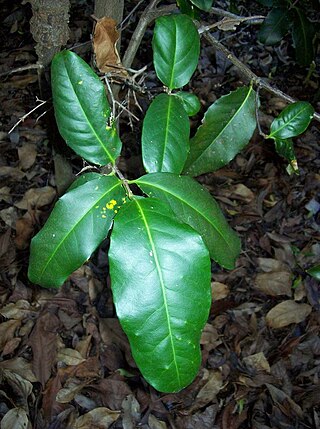
Corynocarpus rupestris, commonly known as the Glenugie karaka, is a rainforest tree found in eastern Australia. It is a rare plant with a ROTAP rating of 2VC-t. There are two sub-species; arborescens is a small hairless shrub or tree up to 13 metres tall with a stem diameter up to 40 cm (16 in), and sub-species rupestris grows only to 6 metres, with a stem diameter up to 17 cm (6.7 in).

Davallia solida var. pyxidata known as the hare's foot fern, is a variety of fern that occurs in eastern Australia and is usually identified as a lithophyte or epiphyte in or near rainforest areas. However, it may also be seen in a few locations west of the Great Dividing Range. Listed as vulnerable in Victoria, occurring in the Grampians.
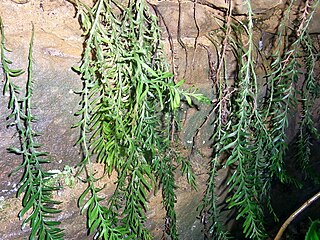
Tmesipteris truncata is a fern ally endemic to eastern Australia. The habitat of this primitive plant is under waterfalls, or in sandstone gullies or rainforests. Commonly referred to as a Fork Fern. It is often found growing on the base of the King Fern. Usually seen as an epiphyte or lithophyte, but it may also appear as a terrestrial plant. Found as far south as Mount Dromedary.
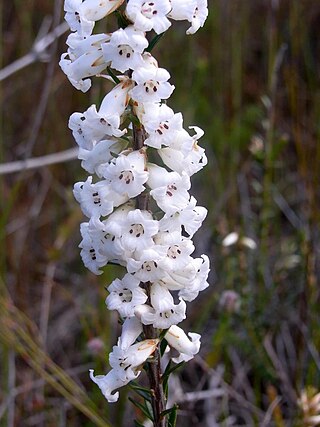
Epacris obtusifolia, commonly known as blunt-leaf heath, is a species of flowering plant from the heath family, Ericaceae, and is endemic to eastern Australia. It is an erect shrub with few stems, crowded, oblong to elliptic leaves and tube-shaped white or cream-coloured flowers arranged along the stems.

Gleichenia alpina, commonly known as alpine coral-fern, is a small fern species that occurs in Tasmania and New Zealand. It grows in alpine and subalpine areas with moist soils and is a part of the Gleichrniaceae family.
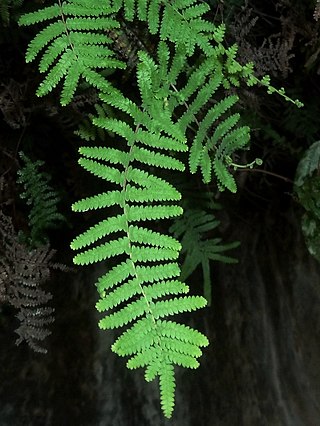
Gleichenia polypodioides (L.) Sm., commonly known as coral fern, kystervaring or ystervaring due to its glabrous, brown, wiry stipes. The species is widespread in south- and east tropical Africa, southern Africa and the western Indian Ocean region. It occurs naturally in a broad coastal belt in South Africa, Lesotho, Eswatini, Angola, Malawi, Burundi, Tanzania, Mozambique, Zimbabwe, Mauritius, Réunion, Amsterdam Island and Madagascar, and was first described by Carl Linnaeus in 1771 under the name Onoclea polypodioides. Often forming dense and impenetrable thickets, sometimes over large areas, this rhizomatous perennial is an important pioneer in disturbed areas such as pine plantations. It is often mistakenly seen as an exotic invader rather than as a useful rehabilitation plant, a source of peat and growing medium, while showing exceptional resistance to herbicides.
Rhizome brown, 1–2.5 mm. in diam., creeping, with long-spined dark-brown scales up to 0.5 mm. in diam., with fronds spaced 2–20 cm. apart. Stipe castaneous, up to 60 cm. long and up to 1.5 mm. in diam., glabrous or with a few scales similar to those on the rhizome, shallowly sulcate. Frond bifurcate to reniform-lunate in outline, with 1 level of false dichotomy in each lateral branch system arising from each side of the terminal bud; all branches bearing distant foliar segments. Aborted apical buds up to 1.2 mm. long, clothed in dark-brown lanceolate laciniate scales. Pinnules linear, up to 7 x 0.75 cm., pinnate, usually glabrous, divided into sessile rounded entire triangular lobes, 3 x 2 mm., green to glaucous below. Sori partially immersed in the lamina, consisting of 2–4 sporangia, each in a separate but adjoining pit.

Schizaea rupestris is a small Australian fern. Most populations are in found in the ranges near Sydney. However, it also occurs near Woolgoolga and Western Australia.
Pimelea rupestris is a species of flowering plant in the family Thymelaeaceae and is endemic to eastern Australia. It is a shrub with hairy young stems, elliptic to egg-shaped leaves with the narrower end towards the base, and heads of white flowers that are either all male or all female.



















